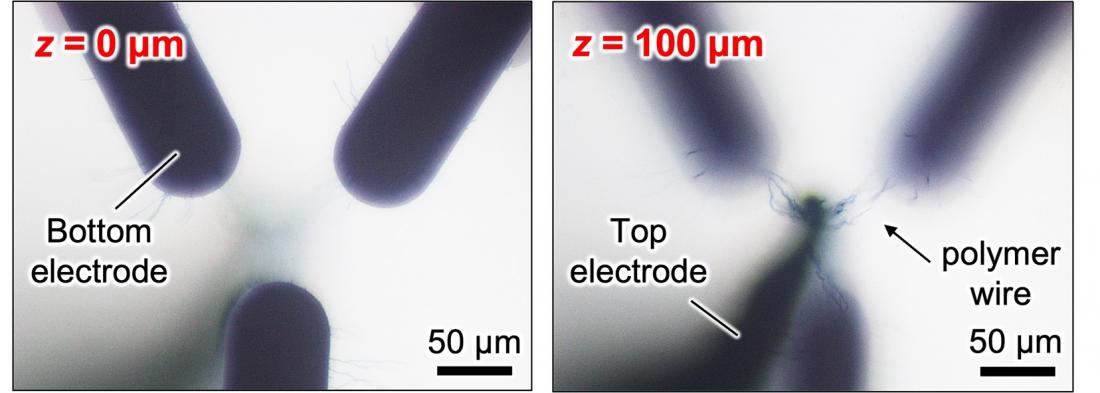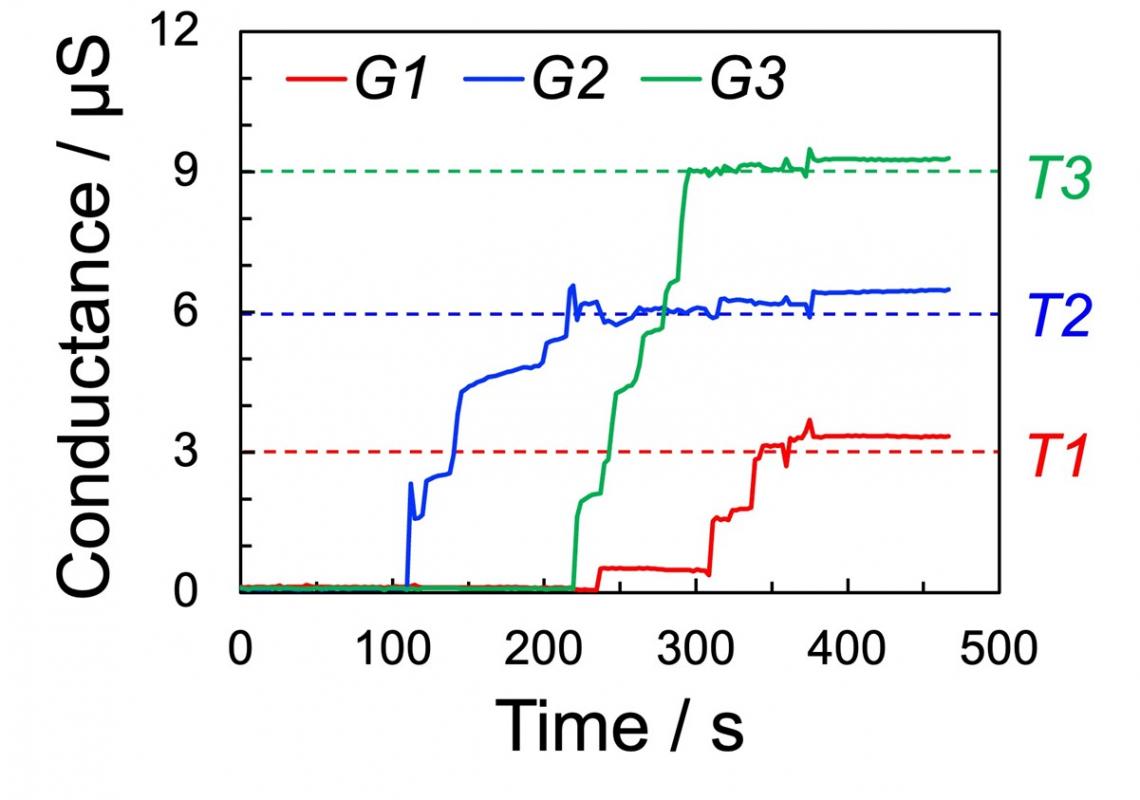Fig. 1
Optical microscopy images of the 3D polymer wiring between a top electrode (TE) and three bottom electrodes (BEs) at the vertical distance from the surface of glass substrate z = 0 and 100 μm.
Researchers from Japan have developed a technique for growing conductive polymer wire connections between electrodes to realize artificial neural networks that overcome the limits of traditional computer hardware
Osaka, Japan – The development of neural networks to create artificial intelligence in computers was originally inspired by how biological systems work. These ‘neuromorphic’ networks, however, run on hardware that looks nothing like a biological brain, which limits performance. Now, researchers from Osaka University and Hokkaido University plan to change this by creating neuromorphic ‘wetware’.
While neural-network models have achieved remarkable success in applications such as image generation and cancer diagnosis, they still lag far behind the general processing abilities of the human brain. In part, this is because they are implemented in software using traditional computer hardware that is not optimized for the millions of parameters and connections that these models typically require.
Neuromorphic wetware, based on memristive devices, could address this problem. A memristive device is a device whose resistance is set by its history of applied voltage and current. In this approach, electropolymerization is used to link electrodes immersed in a precursor solution using wires made of conductive polymer. The resistance of each wire is then tuned using small voltage pulses, resulting in a memristive device.
“The potential to create fast and energy-efficient networks has been shown using 1D or 2D structures,” says senior author Megumi Akai-Kasaya. “Our aim was to extend this approach to the construction of a 3D network.”
Fig. 2
Modification of three conductance values G1, G2, and G3 between the TE and three BEs through 3D polymer wiring.
The researchers were able to grow polymer wires from a common polymer mixture called ‘PEDOT:PSS’, which is highly conductive, transparent, flexible, and stable. A 3D structure of top and bottom electrodes was first immersed in a precursor solution. The PEDOT:PSS wires were then grown between selected electrodes by applying a square-wave voltage on these electrodes, mimicking the formation of synaptic connections through axon guidance in an immature brain.
Once the wire was formed, the characteristics of the wire, especially the conductance, were controlled using small voltage pulses applied to one electrode, which changes the electrical properties of the film surrounding the wires.
“The process is continuous and reversible,” explains lead author Naruki Hagiwara, “and this characteristic is what enables the network to be trained, just like software-based neural networks.”
The fabricated network was used to demonstrate unsupervised Hebbian learning (i.e., when synapses that often fire together strengthen their shared connection over time). What’s more, the researchers were able to precisely control the conductance values of the wires so that the network could complete its tasks. Spike-based learning, another approach to neural networks that more closely mimics the processes of biological neural networks, was also demonstrated by controlling the diameter and conductivity of the wires.
Next, by fabricating a chip with a larger number of electrodes and using microfluidic channels to supply the precursor solution to each electrode, the researchers hope to build a larger and more powerful network. Overall, the approach determined in this study is a big step toward the realization of neuromorphic wetware and closing the gap between the cognitive abilities of humans and computers.
###
The article, “Fabrication and Training of 3D Conductive Polymer Networks for Neuromorphic Wetware,” was published in Advanced Functional Materials at DOI: https://doi.org/10.1002/adfm.202300903
Fig. 3
Acquisition of associative memory through Hebbian learning on the 3D polymer wiring system, indicating successful associations between colors and corresponding fruits.
About Osaka University
Osaka University was founded in 1931 as one of the seven imperial universities of Japan and is now one of Japan's leading comprehensive universities with a broad disciplinary spectrum. This strength is coupled with a singular drive for innovation that extends throughout the scientific process, from fundamental research to the creation of applied technology with positive economic impacts. Its commitment to innovation has been recognized in Japan and around the world, being named Japan's most innovative university in 2015 (Reuters 2015 Top 100) and one of the most innovative institutions in the world in 2017 (Innovative Universities and the Nature Index Innovation 2017). Now, Osaka University is leveraging its role as a Designated National University Corporation selected by the Ministry of Education, Culture, Sports, Science and Technology to contribute to innovation for human welfare, sustainable development of society, and social transformation.
Website: https://resou.osaka-u.ac.jp/en





